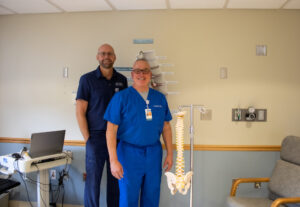
At Hillsdale Hospital, the stellate ganglion block (SGB) has long been used to treat and relieve pain associated with a variety of conditions, including complex regional pain syndrome, sympathetic mediated pain and herpes zoster (shingles). The SGB procedure targets the stellate ganglion, a collection of sympathetic nerves found at the level of the sixth and seventh cervical vertebrae (the last two vertebrae of the neck). They are part of the sympathetic nervous system and supply the face and arm. It gets the name “stellate” from its star shape, and it extensively connects with the brain’s cerebral cortex, hypothalamus, amygdala and hippocampus.
When performing the SGB procedure for pain management, the procedure temporarily curbs the sympathetic autonomic nervous system to improve the blood supply of the region, which may reduce pain, swelling, color and sweating changes of the upper extremity.
“The SGB procedure is proven to help manage chronic pain, and we’ve used it with great success for a long time at Hillsdale,” CRNA Andrew Biegner shared. “We’re now seeing that it can help treat long COVID symptoms as well.”
Two of the most common symptoms of long COVID are loss of taste and loss of smell (clinically known as anosmia/parosmia and dysgeusia). It’s recently been discovered that an SGB can help a patient regain taste and smell — a life-changing opportunity for patients suffering from the loss of either of these senses. For the treatment of the loss of taste or the loss of smell, SGB shuts down the sympathetic autonomic nervous system and forces the central nervous system to recalibrate, resetting the sympathetic activation of these nerves to a lower level.
“I tell patients to think of it as being similar to an electrician throwing a switch and recalibrating electrical circuits,” Biegner explained. “Just like that can often correct an electrical problem, the SGB can often correct the loss of taste or smell, at least to some degree.”
For patients who no longer have a proper sense of smell or taste, this procedure can drastically improve their quality of life. Some have waited years to get relief from these symptoms. While it does not work 100% of the time or for every patient, it is a treatment worth exploring. It’s also important to note that long COVID treatment is off-label for SGB procedures, which means insurance will not cover the cost. Patients will need to pay $650 out-of-pocket for the procedure. However, this is all explained in an initial consultation before the procedure ever takes place.
“I treated someone who couldn’t taste or smell for three years and was desperately searching for answers,” said Biegner. “The SGB was successful in that case. Seeing patients like that regain their senses, right in front of you, is extremely emotional and rewarding.”
To learn more about the procedure, either for pain management or the treatment of long COVID symptoms, please call the Hillsdale Hospital’s Center for Pain Management at (517) 437-5417
